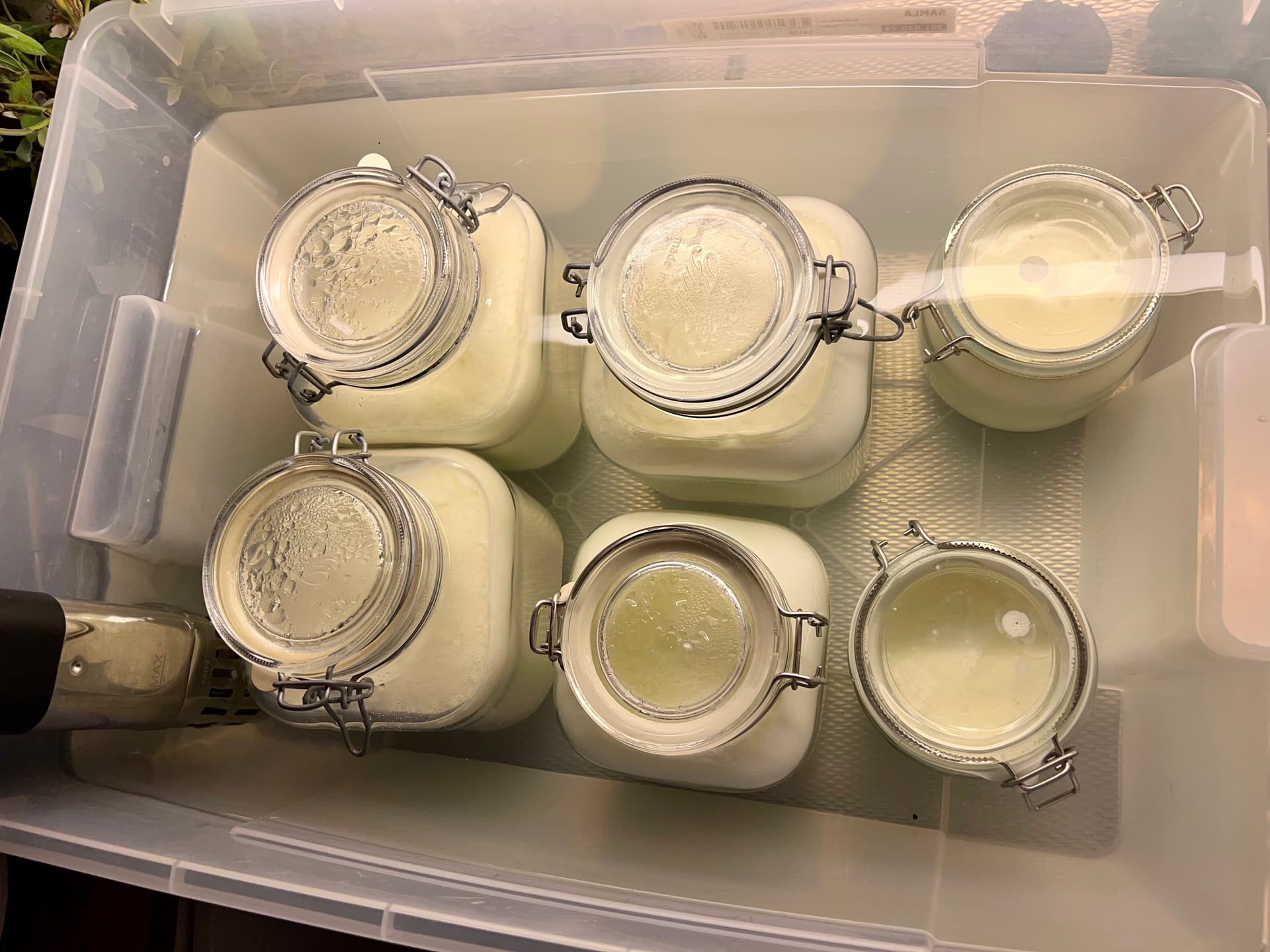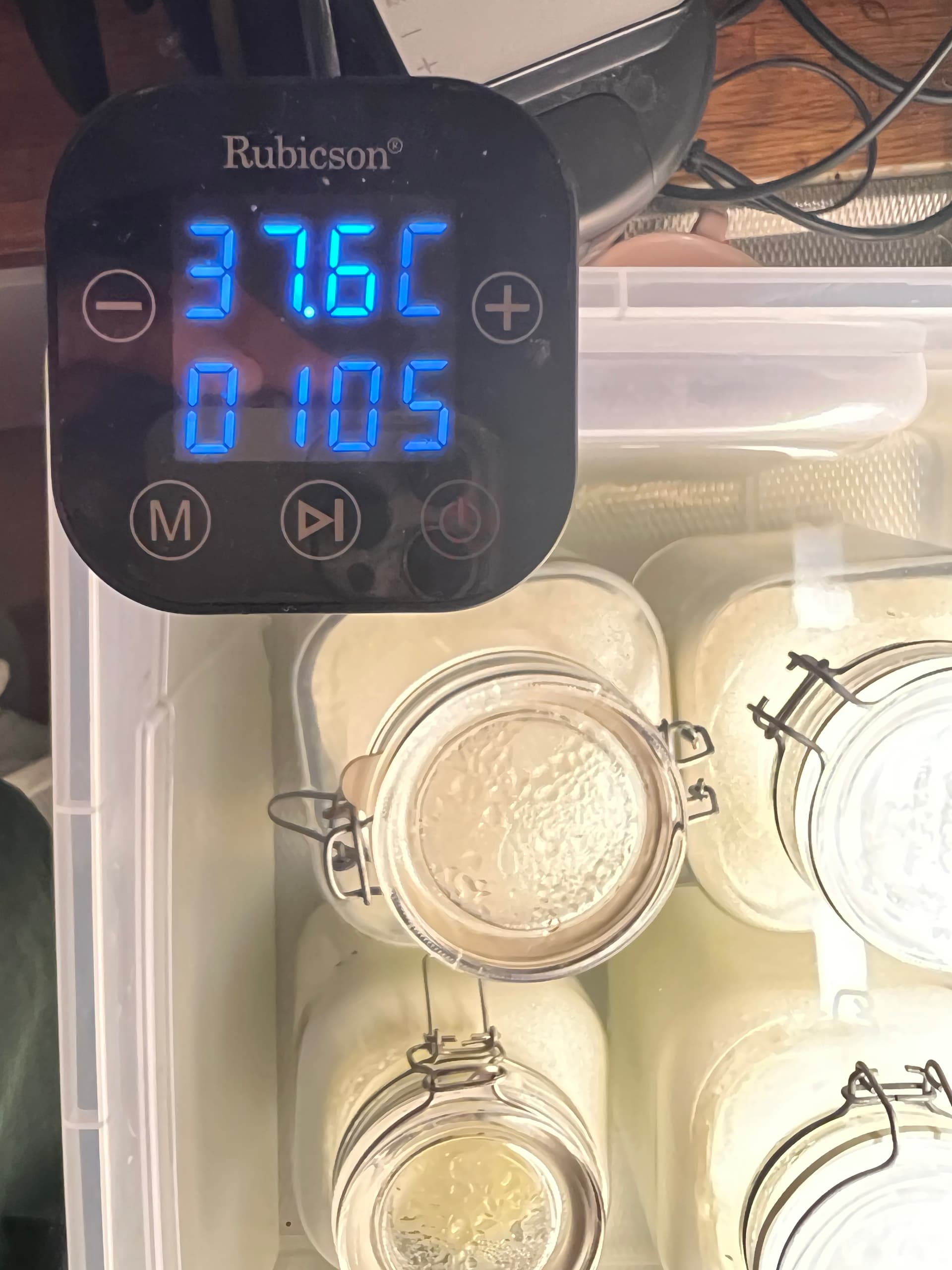related:
See another post about a certain
“Lactobacillus reuteri NCIMB 30242 has the ability to safely reduce cholesterol levels”
How time intensive is this for you?
L reuteri seems to be the best thing out there for gut health, with a lot of other benefits like this. Seems a no-brainer- I’ve hesitated out of pure laziness/hatred of all things cooking! If I were still with my ex, who loves all things cooking, I’d already be consuming it.
I’m really well set up for it, so it’s nothing. We have a Sous Vide, and I cut a hole in the top of a plastic cooler to keep the electric stuff and display visible. 8 quart jars of milk with 2 tbls inulin (this generates gas in some people even after being in with the bacteria for 36 hours at 99.5 degrees). Crunch up the tablets with a mortar and pestle, pour them in. I stir with a battery powered frother? They use it with coffee and I don’t drink coffee so honestly I don’t know what it’s for.
The tricky part is stirring in the inulin. If thrown in it turns to glue and will not dissolve. You need to gently tap it on the top of the jar so that it goes in slowly as the milk is spinning past.
Yakult is another lactobacteria that is said to do amazing things. Lactobacteria Casei and the species is Shirota. You can buy at walmart and make it the same way only with this strain you go to 109F for 36 hours.
Works great with goat milk straight out of the goat. I use clean stuff, but sterilization is not necessary. These guys are killers and take care of it themselves.
If I did not have fresh milk available I would use half and half.
Forgot to mention that the Sous Vide goes into the water that surrounds the jars. It has a pump and thermometer and does all the thinking for you. Also I had to make a metal bar across the middle of the cooler to hang the Sous Vide. That was the hard part.
Details on how to make the yogurt (link), and more discussions: Probiotic Microbes Sustain Youthful Serum Testosterone Levels and Testicular Size in Aging Mice
and Addition of inulin to probiotic yogurt: Viability of probiotic bacteria and sensory characteristics
That mouse study was fantastic! There is so much stuff on this site that I have not gotten to.
I should have measured my balls before I started doing this. Lol. I do have my testosterone every year for the last several years, but it has been dropping and dropping and dropping and I asked my doc about it and he said I don’t need it anyway, but he’d give it to me if I want it. So I can’t wait to see if this moves it at all.
I’ve been making loads of Yoghurt from the strains L. Reuteri 6475 and Lactovitalis pro, witch is mix of 12 proven probiotics.
Didn’t notice my balls getting any bigger, but my boss made me aware of that I hadn’t had a sick day during the 8 months I had eaten the yoghurt.
Life been busy lately so haven’t done any yoghurt in a while. But bought 12 liters of fresh milk I will pasteurize to night.
I have also made some yoghurt from a fermented blueberry juice sold in Sweden, that uses plantaris 299. V. Pills were super expensive so saved me some money!
I’ve also played around with the whey, using it to ferment cabbage/vegetables, and making sparkling ginger/honey-soda…
Just make sure that all utensils are decently clean. I usually put the jars in the oven before filling them with the pasteurized milk. 15 minutes 120 C. Should do the trick.
I know some people are less anal about sterilizing, but I feed my baby with it, and also want to be able regrow from old batch without getting changes in taste, which you can get over time when the kitchen bacteria join the party ![]()
How do you make soda from whey? I use my kefir whey for soups and sauces. The idea to make soda from it is exciting. Pls share.
I used to do it some when I had kefir:
There will be alcohol.
I pour the whey thru a coffee filter to get rid of any yoghurt. Then together with grated ginger, ad it to a precooked, cooled mixture of lemon and honey.
Pored it to bottles with snap lids and let it sit above my fridge where it’s pretty warm during summer. I think it took 4-5 days to get a fresh acidic taste and some carbon dioxide.
The amount of alcohol I’d say was negligible. I served it to my kids ![]()
Kéfir contains yeast. My yoghurt doesn’t. But on purpose skipped to cook the ginger, and think it brought some natural yeast.
Wondering if sugar is a needed component to fe egg mental it. I don’t use added sugar in any of my foods. Does it mean that ginger fortified water will ferment if mixed with whey? Will experiment…
The yeast and bacteria need some sugar to eat. If I remember correctly glucose syrup is the best, but I think others will do. I may have used a mix of sugar and honey.
U could try a not so sweet version and let it sit a bit longer to create more bacteria and alcohol ![]()
You could try inulin as an experiment. That’s what I feed my yogurt per Davis. It works well and leftover is good for your gut buddies.
FWIW
Last night {09/04/2023] Used approximately 1 quart {In a glass Pyrex yec bowl of light cream add one shot 2.7oz/80ml of Yakult{which is Lacticaseibacillus casei Shirota bacteria.[2][3] The strain was originally classified as being Lactobacillus casei.[2]
I forgot to put in the inulin, did put two scoops of insulin several hours later. Placed bowl in water bath incubator at 100°F for 24 hours-
First time I try this bacteria Lacticaseibacillus casei Shirota
As I post this the light cream is appropriate 20 hours at 100°F and the cream is nice and stif.
Have not tried it yet.
Point is you can be read any bacteria yourself with a small amount to start.
I did pretty much the same last night: used 2 quarts of 1% organic milk, added Lactobacillus Reuteri to my regular kefir culture, then added some inulin and left all on a kitchen counter at room temperature overnight. 10 hours later I have a delicious thick kefir to enjoy with the best strains of bacteria.
Adding L. Reuteri to a kéfir starter could work. But chances are that L. Reuteri that thrive around body temp, will be out numbered by kéfir yeast and bacteria in room temp. I would recommend you to make a small starter with much L. Reuteri in a small jar with milk, and then make a bigger batch from that starter.
22 hours at 37,6 C.
One “ice cube” of L. Reuteri 6475 in each jar, 12 liters in total.
16 hours usually work fine, but didn’t have 2 ice cubes for the 3 L jars so decided to let it cook for some extra time… bacteria count double about every third hour, so all jars will be more “sour” than at 16 h. especially the smaller 1 L. jars.
The quality of the research on L. reuteri NCIMB 30242 research quality is quite good, overall suggesting a ~10% drop in LDL-C and ~8% in Apo(b) 100. If there is a criticism of the research it is mostly of short to mid-term duration.
Does anyone have any personal pre/post experience with its effects on their lipids? I have been taking Life Extension’s capsules for more than a month now and will have my lipids tested a month or so from now.
I make kefir with reuteri and eat it daily for breakfast. Have been doing it for approve year. My LD and Apo B dropped significantly (69 and 66), however I was on Lipitor and ezetimibe as well. I stopped taking Lipitor and continue only ezetimibe and reuteri. Will remeasure my cholesterol in couple weeks.

